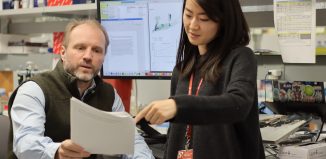BNL’s Rogers studies flora above the Arctic Circle
Alistair Rogers left his home in Rocky Point and traveled to Barrow, Alaska, which is above the Arctic Circle and is the northernmost community in the United States, for five weeks this summer. Rogers foregoes the cycling group he enjoys on Long Island and a home with a comfortable bed to live in a dormitory-style room, complete with bunk beds.
Where Rogers works, the mosquitoes can be so aggressive that he wears a full bodysuit, complete with hood and gloves. Any piece of exposed skin becomes a target for bloodthirsty bugs.
For Rogers, a plant physiologist in the Environmental Sciences Department at Brookhaven National Laboratory, Barrow is an ideal location to study how tundra plants, many of which are grasses and small shrubs, take up carbon dioxide. His research will contribute to improving models other scientists have created for the climate in 2050 and beyond. Rogers is a part of a multidisciplinary study called Next-Generation Ecosystems Experiments in the Arctic. The 120 scientists in the study come from Oak Ridge, Lawrence Berkeley and Los Alamos National Laboratories, the University of Alaska, Fairbanks and several other institutions.
The group measures the changes in the physical, chemical and biological response of land-based ecosystems in Alaska. One of the biggest unknowns is how much carbon dioxide some of these plants can take up as a part of photosynthesis.
Rogers’ data, he said, shows that the models’ assumptions were wrong: the models underestimate the capacity for carbon dioxide uptake by three to five times. Armed with a Licor 6400 photosynthesis instrument, Rogers puts a leaf in the chamber and controls carbon dioxide concentration, light intensity, humidity and temperature. The instrument measures the amount of carbon dioxide and water released.
The Arctic is an especially important region to study because the permafrost is beginning to thaw and degrade. Once that happens, dead plants trapped in the ice release their stored carbon dioxide, which has the potential to increase the rate of global climate change, he said.
“The greatest uncertainty surrounds the fate of frozen organic matter that only now is becoming accessible to microbial degradation as permafrost thaws and degrades,” he explained. The thaw also creates opportunities for plants because of the availability of nutrients. The question, he explained is whether the greening of the Arctic will counter the release of old carbon.
Other researchers have appreciated how Rogers has contributed to the group’s understanding of the tundra. “While many scientists classically trained in biochemistry stay in the laboratory and wear a white lab coat, Alistair has taken the sophistication of a modern-day laboratory to the frozen tundra,” said Stan Wullschleger, the projector director for NGEE Arctic from Oak Ridge National Laboratory.
“We have Alistair and a few others to thank for making measurements that show how much more there is to know about the sensitive and poorly understood ecosystems.”
Wullschleger said the soil and plants in the arctic are “critical to our understanding of how our planet works.” The mosquitoes and the separation from Long Island notwithstanding, Rogers described the experience of traveling to Barrow as “a real privilege. Not many people get to go up to the top of the world.”
He said the local Inupiat still hunt whale. He has eaten something called mikiaq, which is raw whale blubber that is fermented in whale blood for a number of weeks. “I bolted it down as quickly as possible,” he said. “Heavy salting improved the flavor” but it most definitely did not “taste like chicken.”
A native of England, Rogers said he enjoys the Long Island weather. He appreciates the proximity to parks and beaches.
Rogers initially started his scientific career with a focus on animals. He transitioned, however, to plants when he “realized as an undergrad that plants determine the rate of global change.”
Rogers has contributed to the development of the next generation of scientists on Long Island. Three times, the Department of Energy has named the BNL scientist an outstanding mentor for undergraduate research programs: in 2009, 2004, and 2002.
“I really enjoy” mentoring, he said. The questions from curious students can “keep you on your toes and that’s a good thing.”






